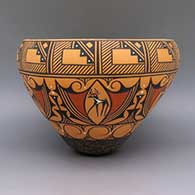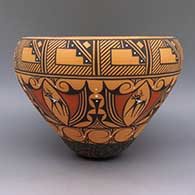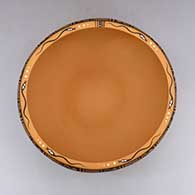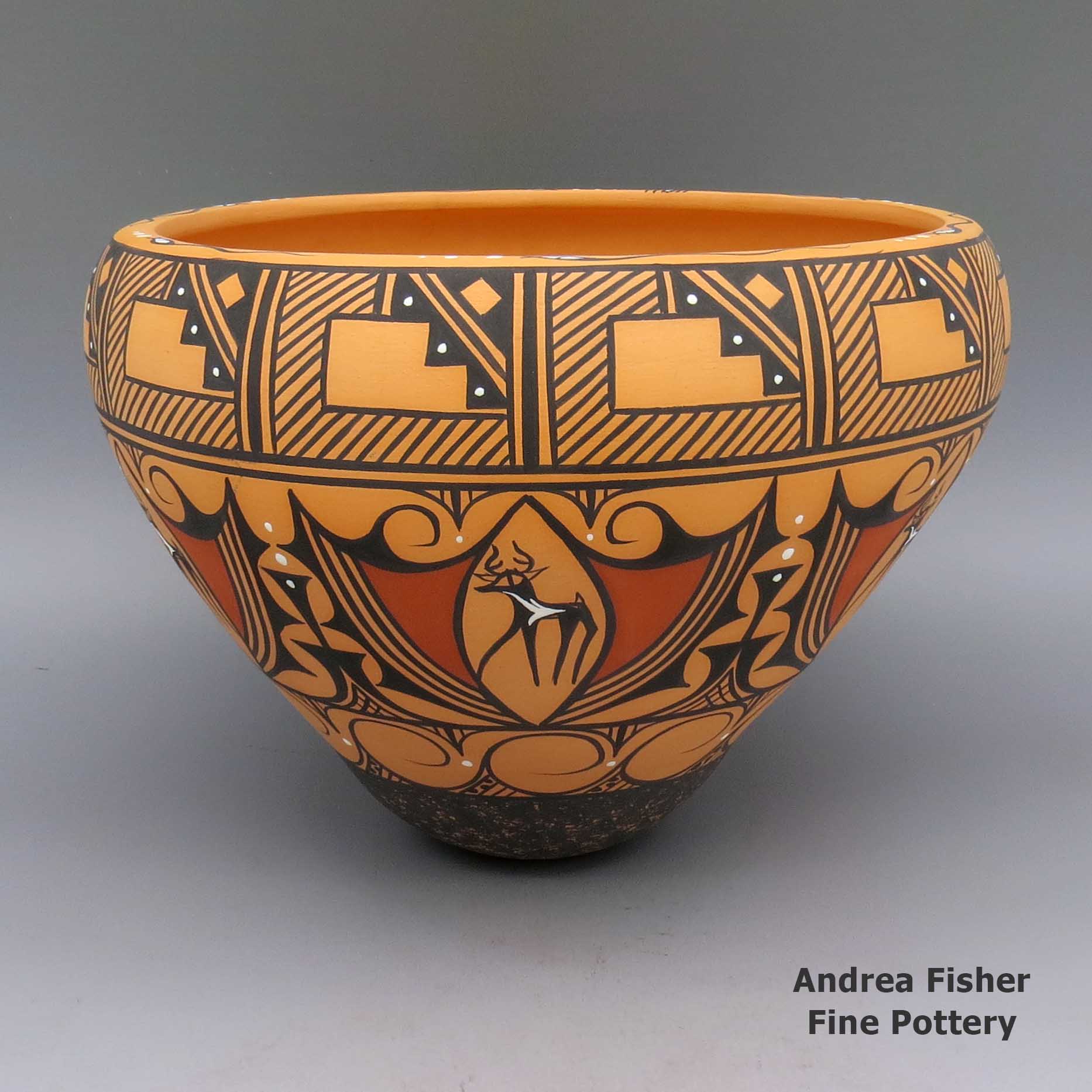
Zuni
$ 850
eszu2g059
Polychrome jar with deer with heart line, snake, kiva step, and geometric design
10.5 in L by 10.5 in W by 7.75 in H
Condition: Very good
Signature: Peynetsa Zuni NM
Tell me more! Buy this piece!
(505) 986-1234 - www.andreafisherpottery.com - All Rights Reserved
Zuni Pueblo
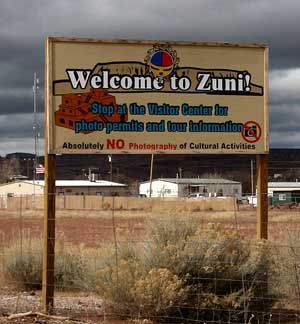
Welcome sign at Zuni Pueblo
Archaeologists have dated some sites on the Zuni Reservation back to the Paleo-Indian Period, more than 4,500 years ago. During the Archaic Period (2,500 BC to 0 AD), the forebears of the Zuni were hunter-gatherers and just beginning to develop agriculture. The Basketmaker Period (0 AD to 700 AD) saw agriculture become more developed and the Zunis were making their first pottery. The Pueblo I Period (700 AD to 1100 AD) saw an expansion of the population and larger settlements were built in the Zuni River area along with the development of the first painted Zuni pottery.
The Pueblo III Period (from 1100 to 1300 AD) saw further population growth in the Zuni River area and a shift from small houses to larger, plaza-oriented villages. The Pueblo IV Period (1300 to 1500 AD) was the time of the great drought and migrations as many tribal groups abandoned the Four Corners area and moved to locations near the Rio Grande, Rio Puerco, Zuni River and Little Colorado River. The main Zuni Pueblo was founded during this time but there were several other large villages in the area, too.
In 1540 there was a major battle fought between the Zunis and the forces of Francisco Vasquez de Coronado. Coronado first approached the pueblo at the end of a four-day religious festival. The Zunis had spilled a line of corn meal across the ground before the entrance to the pueblo, meant to signify to the Spanish that they shouldn't cross the line yet. Coronado interpreted that line of corn meal as an act of war and immediately ordered his soldiers to attack.
Coronado was almost killed in the fighting but his soldiers did finally win the battle. As Coronado and his men brought horses and sheep with them, they were probably the first such livestock the Zunis had ever seen. The gold the Spaniards were looking for: it turned out to be Sikyatki Polychrome bowls and jars, yellow clay gifts from the Hopis to the Zunis.
The Zunis did equip Coronado with a guide from the eastern Plains, someone who'd somehow made his way as a lone traveler to Hawikku. That refugee was supposed to be a guide for Coronado and his men but he was instructed by the Zunis to take Coronado into the Plains and get him lost there. When Coronado finally realized that, more than a year later, he ordered the guide executed, then turned his men around and headed back to Zuni and Mexico.
When he passed by Zuni in 1542, he left three Mexican Indians behind with the tribe. They most likely informed the tribal leaders of the extent of the Spanish domain in Mexico and the power they exercised there.
Except for a couple passing exploratory expeditions, they were left alone until the 1620s. Then came the friars who oversaw the construction of a mission church at Hawikku in 1629. At first the Zunis were friendly with the priests but with the forced labor requirements and forced religious conversions, the priests wore that welcome out quickly. Relations had changed drastically for the worse by the time of the Pueblo Revolt of 1680. The Zunis killed the priests and burned the missions but they preserved the relics and icons the priests had brought from Spain.
The tribe built a village near their fortress at Dowa Yalanne and prepared to defend their people and way of life against the Spanish army. When Don Diego de Vargas arrived with troops in 1692, he attacked the fortress twice and failed. Then he negotiated with the Zuni war chief and was allowed to ascend to the top of Dowa Yalanne. He found many relics from the destroyed missions there. With that knowledge, he arranged a peace between the Spanish and the tribe. Between 1693 and 1700 the tribe consolidated all their small villages into what is now the Pueblo of Zuni.
The railroads arrived in New Mexico in the 1880s and right behind them came the first Anglo traders. Over the next 50 years Zuni pottery turned more and more to what the traders wanted. With the push into mass production, the quality fell off. The end result was the value of Zuni pottery fell way off and the potters tired of what they were doing. Pottery making dropped off in the 1940s until only ceremonial vessels were being made. Catalina Zunie was teaching pottery making at the Zuni Day School through this time period but the Zuni pottery revival didn't really begin until Daisy Hooee began teaching pottery making at Zuni High School in the 1960s and 1970s.
An accomplished Hopi-Tewa potter with an excellent pedigree, Daisy applied herself to learning about Zuni pottery and became a consummate Zuni potter. She retired from teaching at the high school in 1974. Jennie Laate, an Acoma woman who married into Zuni and learned the Zuni way from Daisy Hooee, took over teaching the classes. Many of today's well known Zuni potters thank Jennie Laate for her teaching and inspiration. She taught until 1990 when she turned the classes over to her student, Noreen Simplicio. Noreen taught the classes for 2 years, then Gabriel Paloma took over.
Josephine Nahohai brought traditional Zuni pottery designs back into the community in the 1980s. Les Namingha has also recently been using more traditional Zuni shapes and designs in his Zuni revival pottery. Today, because so many Zuni potters learned their craft at Zuni High School, they mostly also use electric kilns for firing their works. Other than that, they all use the same traditional methods of gathering and processing the clay, making their pottery and painting their designs, traditional processes that are practiced in virtually the same way in all the pueblos.
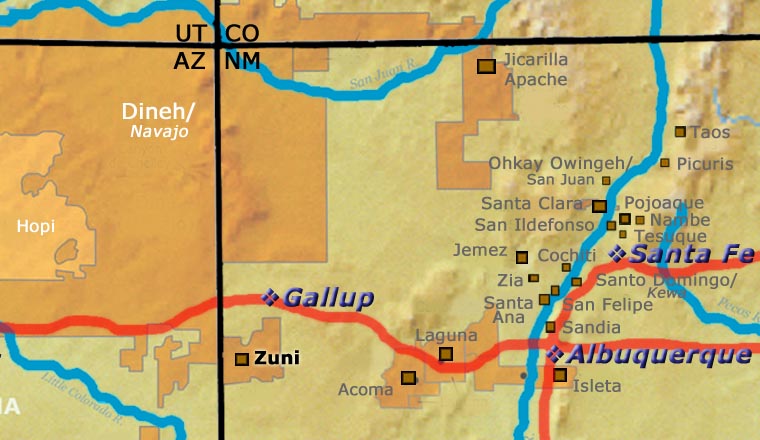
Zuni Pueblo at Wikipedia
Pueblo of Zuni official website
Photo courtesy of Ken Lund, Creative Commons Attribution-Share Alike License 2.0 Generic
Zuni Teaching Tree
Disclaimer: This "teaching tree" is a best effort on our part to determine who the potters are in this group and arrange them in a generational order.
The pottery tradition at Zuni almost died out until Daisy Hooee (granddaughter of Nampeyo of Hano, Hopi-Tewa) took on the job of teaching pottery at Zuni High School in 1960. She was recruited for the job by Catalina Zunie, a Zuni potter who had spent several years just trying to get pottery on the school curriculum. Daisy also spent a year working with Catalina to become a consummate Zuni potter herself before she started teaching.
There have been several teachers at Zuni High since then and for some students, learning from their parents (who were former Zuni High students) has helped to strengthen the tradition. This diagram is subject to change should we get better info.
- Daisy Hooee Nampeyo taught 1960-1974
- Shirley Benn
- Jennie Laate taught 1974-1990
- Carlos Laate
- Gabriel Paloma
- Agnes Peynetsa
- Anderson Peynetsa & Avelia Peynetsa
- Anderson Jamie Peynetsa
- Dominic Laweka
- Priscilla Peynetsa & Daryl Westika
- Gaylon Westika
- Paula Quam
- Brian Tsethlikai and Yvonne Nashboo
Some of the above info is drawn from Southern Pueblo Pottery, 2000 Artist Biographies, by Gregory Schaaf, © 2002, Center for Indigenous Arts & Studies
Other info is derived from personal contacts with family members and through interminable searches of the Internet and cross-examination of the data found.
Copyright © 1998-2024 by


